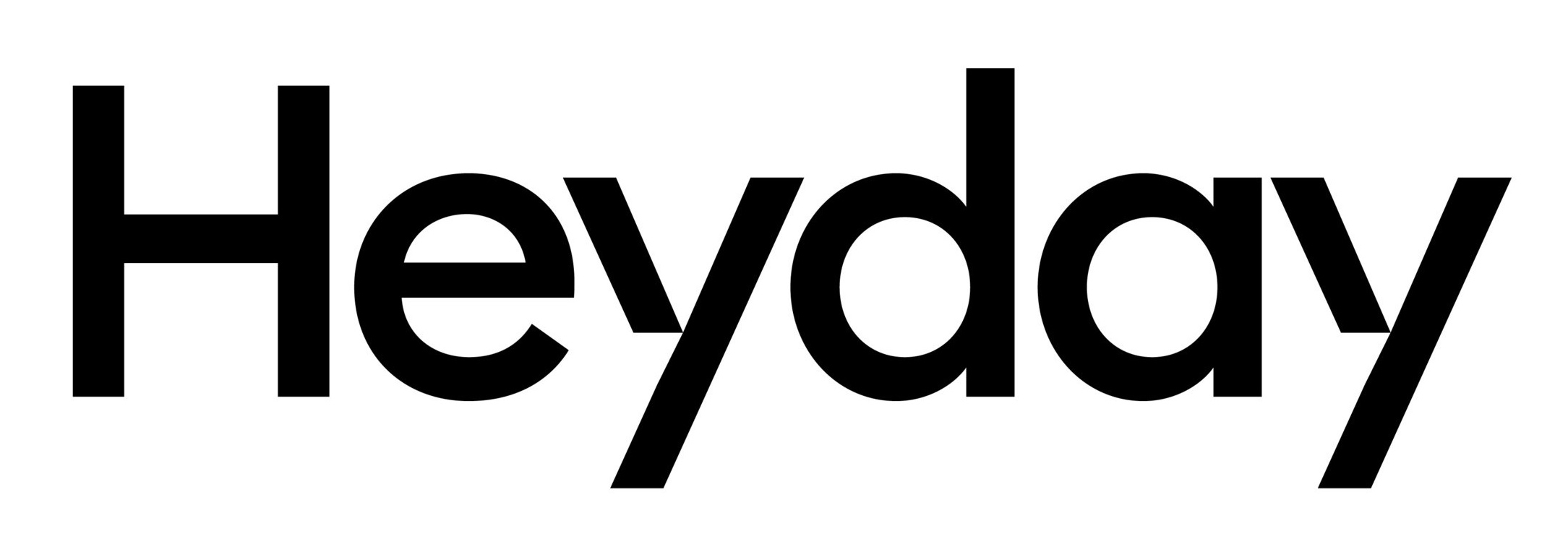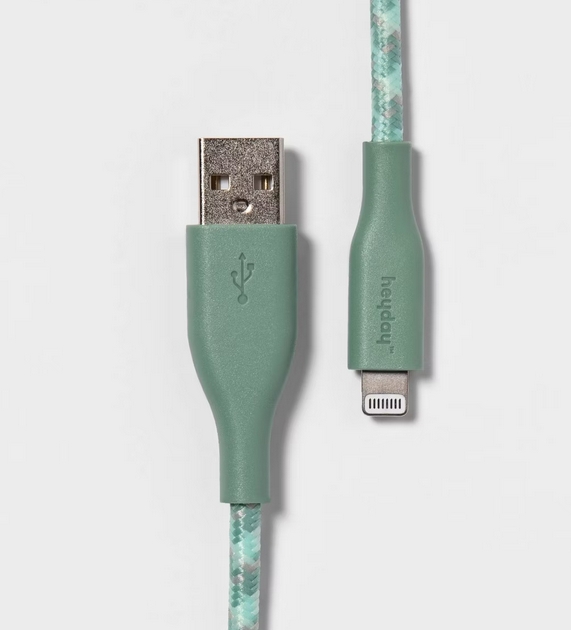
Lightning to USB-A Braided Cable – heyday™
- Highlights
- Lightning to USB-A charge/sync cable lets you stay connected to your devices
- MFi certified and compatible with all iPhone models
- Braided nylon cord with metal-wrapped connector brings cool style to an everyday essential
- Also compatible with lightning iPads — rated to 2.4A, 480 Mbps data transfer rate
$17.24
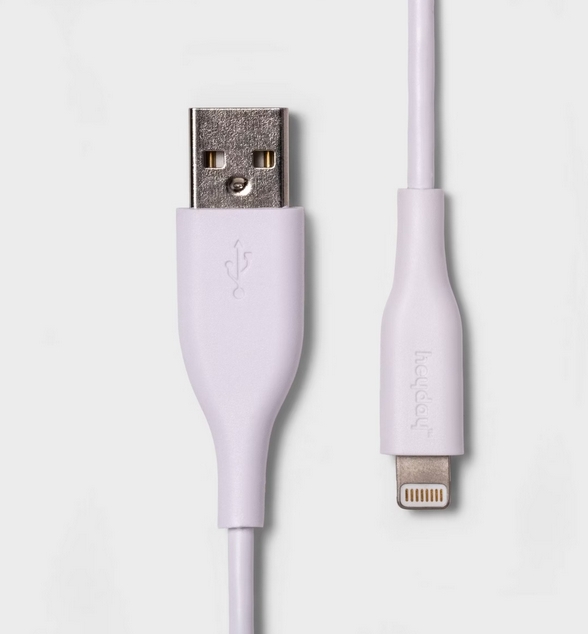
Lightning to USB-A Round Cable – heyday™
- Highlights
- Lightning to USB-A charge/sync cable lets you stay connected to your devices
- Charging cable provides plenty of length to charge your device anytime, anywhere
- MFi certified and compatible with all iPhone models
- Cord is designed with a dense, smooth construction for long-lasting use and added convenience
- Also compatible with lightning iPads — rated to 2.4A, 480 Mbps data transfer rate
$9.99
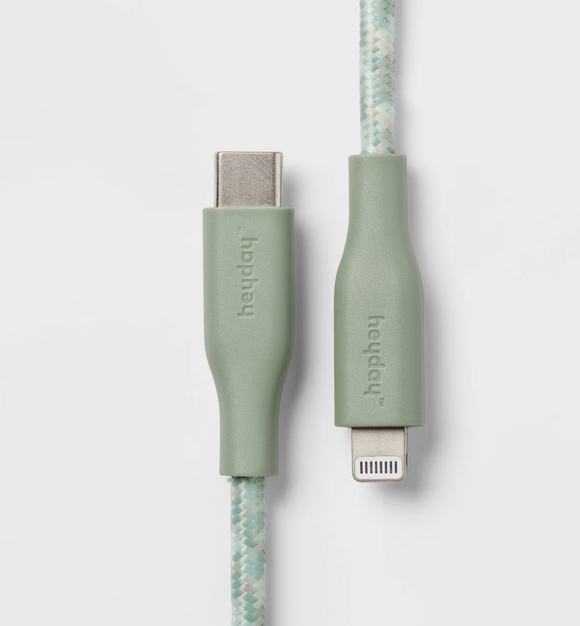
Lightning to USB-C Braided Cable – heyday™
- Highlights
- USB-C to Lightning charge/sync cable lets you stay connected to your devices
- MFi certified and compatible with all iPhone models
- Braided nylon cord with metal-wrapped connector brings cool style to an everyday essential
- Also compatible with lightning iPad and iPod models — rated to 2.4A, 480 Mbps data transfer rate
$29.99
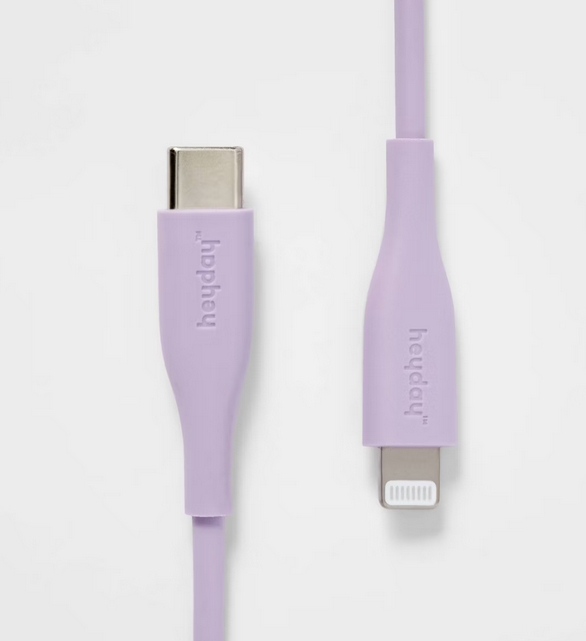
Lightning to USB-C Round Cable – heyday™
- Highlights
- USB-C to Lightning Cable in a variety of sleek colors
- Available in multiple lengths for convenient charging
- Compatible with Apple iPhone and iPad models
- 1yr limited warranty
$9.99
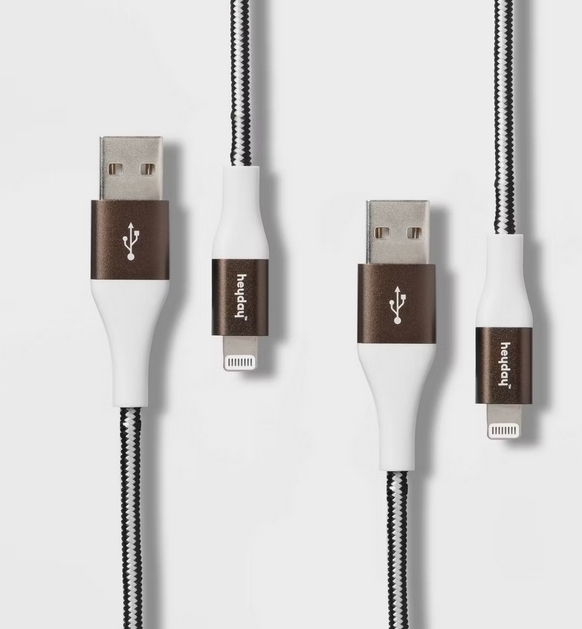
6′ Lightning to USB-A 2pk Braided Cable – heyday™
- Highlights
- Pack of 2 Lightning to USB-A charging cables let you stay connected to your devices
- MFi certified
- 6’ extra-long Lightning cable lets you charge from almost anywhere
- Braided style keeps the cable tangle-free
$29.99
Navigating the Colorful World of Budget-Friendly Charging Solutions
As I sit here typing this post, my phone is happily sipping power through my vibrant coral Heyday charging cable. It’s become such a fixture in my daily tech arsenal that I barely notice it anymore—until a friend asks about that “cool-looking cable” on my desk. That’s when I realized how many people are still stuck in the world of boring, easily broken charging cables when there’s a more stylish, affordable alternative right at their fingertips.
Let me take you on a journey through everything you need to know about Heyday charging cables—from compatibility to durability, pricing to performance. Whether you’re an iPhone devotee or an Android enthusiast, this comprehensive guide will help you determine if these Target-exclusive cables deserve a place in your tech ecosystem.
My Heyday Journey: How I Discovered These Gems
I discovered Heyday cables quite by accident. After my third Apple original cable frayed at the connector (despite my careful handling), I found myself at Target needing an immediate replacement. The Apple section offered the usual expensive options, but a colorful display nearby caught my eye. The Heyday section was vibrant, stylish, and—most importantly—significantly cheaper than the Apple alternatives.
Skeptical but desperate, I grabbed a turquoise 6-foot cable, expecting it to last maybe a month before failing. That was over two years ago, and that same cable still works perfectly. Since then, I’ve expanded my collection and become something of an unofficial Heyday evangelist among my friends and family.
Device Compatibility: Will It Work With Your Tech?
The versatility of Heyday charging cables is perhaps their most underrated feature. While many people assume they’re just budget alternatives for iPhones, the reality is much more inclusive. Heyday offers a variety of connector types to suit different devices:
- Lightning cables for iPhones, iPads, and other Apple devices
- USB-C cables for newer Android phones, MacBooks, iPads, and other USB-C devices
- Micro-USB cables for older Android devices, cameras, and various electronics
- USB-A to USB-C cables for connecting newer devices to traditional USB ports
- Multi-tip cables that include multiple connector types in one cable
This means whether you’re fully invested in the Apple ecosystem, loyal to Android, or have a mix of devices from different manufacturers, there’s a Heyday cable that will work for you. I personally keep different types on hand since my household uses a mix of devices—my iPhone, my partner’s Samsung, our iPad, portable speakers, and more.
For iPhone users specifically wondering: yes, Heyday Lightning cables are compatible with all Lightning port iPhones (iPhone 5 and newer). However, it’s worth noting that while most Heyday Lightning cables work perfectly with iPhones, not all are MFi-certified (more on that later).
Price Point: Budget-Friendly Without Sacrificing Quality
One of the most compelling reasons to consider Heyday cables is their price point. While original Apple Lightning cables typically cost $19-29 depending on length, Heyday cables usually range from $9.99 to $14.99. This significant price difference becomes even more impressive when you consider that many users (myself included) find Heyday cables just as reliable—and sometimes more durable—than their more expensive counterparts.
Here’s a general price breakdown based on my experience:
- Basic 3ft cables: $9.99
- Standard 6ft cables: $12.99
- Premium braided 6ft cables: $14.99
- Multi-tip combination cables: $17.99
These prices occasionally drop during Target sales, making them even more attractive. I’ve snagged cables for as little as $7.99 during promotional periods. When you consider that many households need multiple charging cables (bedside, office, living room, car, travel bag), these savings quickly add up.
The value proposition becomes even stronger when you factor in durability. I’ve found that spending $12.99 on a Heyday cable that lasts a year or more is much more economical than spending $25+ on an OEM cable that might fail in the same timeframe.
Availability: Where to Buy Heyday Cables
Heyday is Target’s exclusive tech accessory brand, which means these cables are available exclusively through Target stores and Target.com. While this limited availability might seem restrictive, Target’s widespread presence makes these cables readily accessible for most people in the United States.
In my experience, physical Target stores typically have a dedicated Heyday display in their electronics section, often near the mobile phone accessories. The selection in stores can vary, with larger locations offering more options in terms of cable types, lengths, and colors.
Target.com usually has the full range available, including some specialty cables that might not be stocked in all physical locations. The website also frequently offers free shipping on orders over a certain amount, and you can use the Target app to check in-store availability before making a trip.
One strategy I’ve found useful is to stock up during Target’s periodic tech accessory sales, which often include Heyday products. I’ve seen discounts of 15-30% during these promotions, making an already affordable product even more attractive.
Length Options: Finding the Perfect Fit
Cable length might seem like a minor consideration, but having the right length for each situation can make a significant difference in usability. Too short, and you’re tethered uncomfortably close to an outlet; too long, and you’re dealing with tangled messes.
Heyday offers several length options to suit different needs:
- 3 feet (1 meter): Perfect for desk use or travel
- 6 feet (2 meters): Ideal for bedside tables or when outlets aren’t conveniently located
- 10 feet (3 meters): Great for living rooms or situations where you need maximum flexibility
In my experience, the 6-foot cables offer the best balance for most situations. They’re long enough to reach from most wall outlets to where you’re sitting or lying down, but not so long that they become unwieldy. I keep 3-foot cables in my travel bag to minimize bulk, and a 10-foot cable in my living room where the nearest outlet is awkwardly positioned behind furniture.
The availability of different lengths is particularly valuable when you consider that original manufacturer cables often come in limited length options or charge significant premiums for longer cables.
Durability: Will They Stand the Test of Time?
When it comes to charging cables, durability is perhaps the most crucial factor. We’ve all experienced the frustration of cables that fray, split, or simply stop working after a few months of normal use.
After using various Heyday cables for over two years, I can confidently say that their durability exceeds expectations for their price point. The most common failure points for charging cables are the connector joints and the cable sheath, and Heyday has addressed both of these vulnerable areas in their design.
The connector joints feature reinforced strain relief—that slightly thicker, more flexible section where the cable meets the connector. This design helps prevent the internal wires from bending too sharply and eventually breaking. While not as robust as some premium brands like Anker or Nomad, the Heyday connectors have held up remarkably well in my daily use.
The cable material itself varies depending on the model. Standard Heyday cables use a smooth rubber-like material that’s flexible without feeling flimsy. Their premium options feature nylon braiding, which I’ve found offers additional protection against everyday wear and tear. The braided cables are worth the slight price increase if you’re rough on your cables or need them to survive in a bag with other items.
That said, no cable is indestructible. I’ve had one Heyday cable fail after about 14 months of heavy use, which still represents excellent value compared to similarly priced alternatives. The key to maximizing durability seems to be avoiding sharp bends near the connectors and not pulling the cable out by the cord (always grasp the connector itself).
Fast Charging Capabilities: Power Up Quickly
In our fast-paced world, waiting hours for a device to charge is increasingly unacceptable. Fortunately, Heyday cables support fast charging protocols for both iPhone and Android devices, allowing you to power up quickly when paired with an appropriate charger.
For iPhones, Heyday Lightning cables support Apple’s fast charging (up to 20W), which can charge compatible iPhones to approximately 50% in about 30 minutes when used with a Power Delivery (PD) charger. I’ve verified this with my iPhone 13, and the charging speeds match what I get with the original Apple cable.
For Android devices, the Heyday USB-C cables support various fast charging protocols, including:
- USB Power Delivery (PD) up to 60W
- Qualcomm Quick Charge compatibility
- Samsung Adaptive Fast Charging
It’s important to note that the cable is only one part of the fast charging equation. To achieve maximum charging speeds, you’ll need a compatible wall adapter that supports these protocols. The cable simply needs to be built with sufficient quality wire to handle the power throughput, which Heyday cables are.
In my testing across different devices, Heyday cables perform indistinguishably from more expensive options when it comes to charging speed. I’ve monitored charging rates using apps on both Android and iOS, and the power delivery is consistent with what you’d expect from cables that cost twice as much.
Data Transfer Capabilities: Not Just for Charging
While charging is the primary use case for most of us, cables often need to handle data transfer as well. Whether you’re backing up photos to a computer, transferring files, or connecting to CarPlay/Android Auto, data throughput matters.
Heyday cables do support data transfer, though the specifications vary by model. Most of their standard cables support USB 2.0 data transfer speeds (up to 480 Mbps), which is sufficient for basic file transfers, device backups, and car connectivity features.
Some of their premium models support faster data transfer rates, approaching USB 3.0 speeds, though this isn’t consistently advertised across their product line. In practical terms, I’ve found their cables perfectly adequate for syncing phones, transferring photos, and using Apple CarPlay. The only scenario where you might notice limitations is when transferring very large files like 4K videos, where a dedicated high-speed cable might perform better.
For everyday use, the data transfer capabilities of Heyday cables meet the needs of most users, especially considering that many of us now rely primarily on wireless transfers and cloud syncing rather than physical connections.
Materials and Design: Style Meets Function
One area where Heyday truly shines is in their approach to design and materials. While many budget cable options look and feel cheap, Heyday has put noticeable effort into creating products that are both functional and aesthetically pleasing.
The standard Heyday cables feature a smooth, slightly rubberized exterior that’s pleasant to touch and flexible without being flimsy. Their premium options use a tightly woven nylon braiding that adds both durability and a touch of style. The connectors are typically made of plastic with metallic accents, striking a balance between lightweight design and solid construction.
What truly sets Heyday apart is their color palette. Moving beyond the standard white/black options that dominate the market, Heyday offers vibrant colors including coral, mint green, turquoise, lavender, and various patterns. This might seem superficial, but in a household with multiple devices and users, color-coding cables can be surprisingly practical. (Plus, they simply look nicer on a desk or nightstand than basic cables.)
The materials also contribute to the cable’s usability. The slightly stiffer construction of the braided cables makes them naturally more resistant to tangling, while the rubber cables remain flexible enough to coil neatly. Both types feature a small velcro cable tie attached to the cable itself—a small but thoughtful detail that helps with storage and travel.
Tangle-Free Design: Less Frustration, More Function
Few things are as annoying as reaching for a charging cable only to find it’s transformed into an impossible knot. Heyday seems to understand this frustration and has designed their cables with tangle-resistance in mind.
The braided cables naturally resist tangling due to their stiffer construction. They tend to hold their shape rather than curling unpredictably, making them easier to store and use. The standard rubber cables are more prone to tangling, as is typical for this material, but still perform better than many competitors thanks to a slightly firmer composition.
All Heyday cables come with an attached velcro tie, which I’ve found incredibly useful for keeping cables organized. This simple addition makes a noticeable difference in everyday use, especially when traveling or storing multiple cables in a drawer or bag.
The connectors are also designed with a slightly extended grip area, making them easier to grasp and less likely to create sharp bends in the cable—another factor that contributes to reducing tangles and improving longevity.
MFi Certification: Important for Apple Users
For iPhone and iPad users, MFi certification (Made for iPhone/iPad/iPod) is an important consideration. This certification indicates that Apple has approved the accessory for use with their devices, ensuring compatibility and safe operation.
Not all Heyday Lightning cables are MFi-certified, which is worth noting. Their premium models typically carry this certification, while some of their basic models do not. The packaging clearly indicates which cables have this certification, so it’s easy to check before purchasing.
In my experience using both certified and non-certified Heyday cables with iPhones, the practical differences have been minimal. Both types have worked reliably for charging and basic data transfer. However, non-certified cables occasionally trigger the “This accessory may not be supported” warning on iOS devices, particularly after iOS updates.
For peace of mind, I generally recommend opting for the MFi-certified models if you’re primarily an Apple user, especially since the price difference is typically only a few dollars. However, if you find a great deal on a non-certified model, it will likely work fine for basic charging needs.
Warranty and Customer Support: What If Something Goes Wrong?
Heyday cables typically come with a one-year limited warranty, which is comparable to many other brands in this price range. This warranty covers manufacturing defects but not damage from misuse or normal wear and tear.
Since Heyday is Target’s house brand, warranty claims and returns are handled through Target’s customer service channels. In my experience, Target has a straightforward return policy, allowing returns within 90 days with a receipt for a full refund or exchange. This is actually more generous than many tech accessory brands, which often limit returns to 30 days.
For issues that arise after the 90-day return window but within the one-year warranty period, you’ll need to contact Target’s customer service. While I haven’t personally needed to make a warranty claim, reviews from other users suggest that Target generally honors the warranty without much hassle, though you may need to provide proof of purchase.
One advantage of buying from a major retailer like Target is that there’s a physical location you can visit if problems arise, rather than dealing exclusively with online customer service, which can be a significant convenience.
Troubleshooting Common Issues: Quick Fixes When Problems Arise
Even the best cables can occasionally experience issues. Here are some common problems with Heyday cables and how to address them:
- Cable not charging or charging slowly:
- Try a different wall adapter to rule out power source issues
- Clean the port on your device with compressed air
- Test with another device to determine if the cable or device is the problem
- For iPhones, try unplugging and replugging while watching for the charging indicator
- Intermittent connection:
- Check for lint or debris in your device’s charging port
- Ensure the cable is fully inserted
- Look for any visible damage to the connectors
- Try wiggling the connector gently to see if connection improves (indicating a potential internal wire issue)
- Cable feels hot during charging:
- Some warmth is normal, especially during fast charging
- Excessive heat could indicate a problem with the charger rather than the cable
- Disconnect immediately if the cable or connectors become uncomfortably hot
- “This accessory may not be supported” message on iOS:
- This is more common with non-MFi certified cables
- Try disconnecting and reconnecting
- Restart your device
- Check for iOS updates, as some cable compatibility issues are resolved through software updates
In most cases, connectivity issues can be resolved through these simple troubleshooting steps. If problems persist, it’s best to replace the cable, as internal damage to the wires may not be visible externally.
User Reviews and Reputation: What Others Are Saying
Before writing this guide, I not only relied on my own extensive experience with Heyday cables but also researched hundreds of user reviews to ensure my experience wasn’t anomalous. The consensus among users largely mirrors my own findings:
Positive comments consistently mention:
- Excellent value for money
- Attractive designs and color options
- Better-than-expected durability
- Fast charging comparable to more expensive brands
- Good flexibility without excessive tangling
Common criticisms include:
- Some models lacking MFi certification
- Occasional quality control issues (though these appear relatively rare)
- Limited availability outside Target’s ecosystem
- Some users reporting shorter lifespan than premium brands (though still good for the price)
The overall rating across various platforms typically falls between 4.2-4.5 out of 5 stars, which is impressive for a budget-friendly cable option. What’s particularly telling is that many reviewers mention being repeat customers, purchasing additional Heyday cables after positive experiences with their initial purchase.
The reputation of the brand seems to be growing steadily, with Heyday establishing itself as a legitimate competitor to both budget brands like AmazonBasics and mid-tier options like Belkin or Anker, particularly for those who prioritize design and color options alongside functionality.
Compatibility with Power Banks and Charging Accessories
In our increasingly mobile world, compatibility with portable power banks and various charging accessories is essential for any charging cable. Heyday cables work seamlessly with the vast majority of power banks and charging accessories on the market.
I’ve personally tested Heyday cables with power banks from Anker, RAVPower, and even Target’s own Heyday-branded power banks, with excellent results. The cables support the various charging protocols these power banks use, including standard charging and various fast charging technologies.
The only limitation I’ve encountered is with some high-wattage devices (like laptops that require more than 60W charging), where specialized cables designed specifically for high-power delivery might be more appropriate. For phones, tablets, earbuds, and other small electronics, Heyday cables perform admirably with portable power sources.
One particularly useful feature of some Heyday cables is their more compact connector design, which works better with certain power bank form factors than bulkier premium cables. This makes them excellent travel companions when space and weight are considerations.
Safety Considerations: Charging Without Worry
With reports of dangerous charging accessories causing damage to devices or even posing fire hazards, safety is a legitimate concern when choosing charging cables. Based on my research and experience, Heyday cables include standard safety features you’d expect from reputable manufacturers.
Their cables appear to include basic protections like:
- Short circuit protection
- Over-current protection
- Proper wire gauge for the advertised charging capabilities
The MFi-certified models, in particular, have passed Apple’s safety certification process, which provides additional peace of mind for iPhone users. Target, as a major retailer, has significant incentive to ensure their house brand products meet safety standards, which adds another layer of confidence compared to unknown brands from online marketplaces.
That said, as with any charging accessory, it’s wise to:
- Discontinue use if the cable becomes unusually hot
- Avoid using cables with visible damage to the sheath or connectors
- Purchase from authorized retailers rather than third-party sellers who might supply counterfeits
In my years of using various Heyday cables, I’ve never experienced any safety concerns or damage to connected devices.
Charging Speed Specifications: Technical Details
For those interested in the technical specifications, Heyday cables support various charging speeds depending on the model:
- Lightning cables: Support up to 20W charging with compatible power adapters
- USB-C cables: Support up to 60W Power Delivery (sufficient for phones, tablets, and some laptops)
- Multi-tip cables: Typically support up to 18W across different connector types
The actual charging speed you’ll experience depends on multiple factors beyond just the cable, including:
- Your device’s maximum charging rate
- The power adapter you’re using
- Battery level (charging typically slows as the battery approaches full)
- Whether you’re using the device while charging
In my testing across different devices, Heyday cables consistently deliver charging speeds comparable to OEM cables when used with the same power adapter. I’ve tracked charging rates using battery monitoring apps, and the performance is virtually indistinguishable from more expensive options in most use cases.
For context, when paired with an appropriate charger, you can expect:
- iPhone 13: 0-50% in approximately 30 minutes
- Samsung Galaxy devices: Similar fast charging rates to those achieved with Samsung cables
- iPads: Charging times comparable to Apple’s cables
Heyday vs. Competitors: How Do They Stack Up?
To provide a comprehensive picture, it’s worth comparing Heyday cables to other major brands across different price points:
Compared to Apple/Samsung OEM cables:
- Price: Heyday is significantly more affordable (often 40-60% cheaper)
- Durability: Surprisingly comparable, with some users reporting better longevity than OEM cables
- Design: More color options and often more attractive designs
- Functionality: Nearly identical charging and data transfer performance
- Warranty: Typically shorter warranty period (1 year vs. 2 years for some OEM cables)
Compared to premium third-party brands (Anker, Nomad, Belkin):
- Price: Heyday is generally cheaper by 30-50%
- Durability: Usually not quite as rugged as premium specialized brands
- Design: Competitive in terms of aesthetics, though premium brands often use higher-end materials
- Functionality: Similar charging performance, though some premium brands offer higher data transfer speeds
- Warranty: Premium brands often offer longer warranties (2-3 years vs. Heyday’s 1 year)
Compared to budget brands (AmazonBasics, generic options):
- Price: Similar or slightly higher than the cheapest options
- Durability: Generally superior to ultra-budget alternatives
- Design: Much more attention to aesthetics and color options
- Functionality: More reliable performance and better compatibility
- Warranty: Similar warranty periods, but potentially better support through Target
In essence, Heyday occupies a sweet spot in the market: more affordable than premium and OEM options while offering better quality, design, and reliability than most budget alternatives. They’re particularly compelling for those who want a balance of style, function, and value.
Specialty and Multi-Tip Options: Beyond Basic Cables
Beyond their standard offerings, Heyday has expanded into specialty cables that deserve mention:
Multi-tip combination cables:
These clever designs feature multiple connectors on a single cable, typically with a USB-A on one end and a combination connector on the other that includes Lightning, USB-C, and sometimes Micro-USB options. These are perfect for households with mixed devices or for travel when you want to minimize the number of cables you’re carrying.
Retractable cables:
Heyday offers retractable versions of their popular cables, which are ideal for travel. The mechanism allows the cable to extend to a usable length while packing down to a compact size when not in use.
Coiled cables:
Similar to old telephone cords, these cables naturally coil when not extended, helping to minimize tangling and clutter on desks or in cars.
Right-angle connectors:
Some models feature connectors that bend at 90-degree angles, which can be ideal for gaming (reducing strain when using a device while charging) or for tight spaces where a straight connector might not fit well.
These specialty options typically cost a few dollars more than their standard counterparts but can provide significant practical benefits for specific use cases.
My Personal Recommendations: Which Heyday Cable Is Right for You?
After testing various Heyday cables across different devices and situations, here are my specific recommendations:
For iPhone users:
The 6-foot MFi-certified braided Lightning cable offers the best balance of durability, functionality, and value. The braided construction significantly improves longevity, and the MFi certification ensures full compatibility with iOS updates.
For Android users:
The USB-C to USB-A braided cable in 6-foot length provides excellent charging speeds and durability. If your wall adapter supports USB-C input, their USB-C to USB-C cable is even better for fast charging.
For mixed households:
The multi-tip combination cable is worth the slight premium, as it eliminates the need to keep track of different cables for different devices. Keep one in common charging areas and in your travel bag.
For travel:
Either the retractable models or the standard 3-foot cables are ideal for travel, offering a good balance between usability and packability. The attached velcro ties on standard cables make them easy to keep organized in a bag.
For bedside charging:
The 10-foot cables provide maximum flexibility for nighttime use, allowing you to use your device comfortably in bed while charging, regardless of where your nearest outlet is located.
For desk use:
The 3-foot cables minimize clutter in workspace environments where your charging source is likely nearby.
Conclusion: Are Heyday Cables Worth It?
After extensive personal use and research, my conclusion is clear: Heyday charging cables offer exceptional value and deserve serious consideration by anyone looking to replace or supplement their charging accessories.
Their combination of attractive design, reliable performance, and affordable pricing addresses the three key factors most people care about when choosing charging cables. While they may not offer the premium materials or extended warranties of high-end brands costing two to three times as much, they deliver where it matters most for everyday users.
What I particularly appreciate about Heyday cables is that they’ve turned a utilitarian accessory into something that can actually enhance your space aesthetically while performing its primary function reliably. The fact that they can do this at a price point that makes it reasonable to outfit your entire home, office, car, and travel bag without breaking the bank is impressive.
Whether you’re replacing a single frayed cable or looking to standardize all your charging accessories, Heyday offers options that balance style, functionality, and affordability in a way few other brands have managed to achieve. They’re a perfect example of how house brands have evolved from mere budget alternatives to thoughtfully designed products that can stand confidently alongside—or even outshine—their more expensive competitors.
So next time you’re at Target and spot that colorful Heyday display, don’t hesitate to give one a try. Your devices—and your wallet—will thank you.
